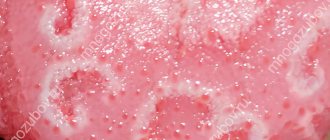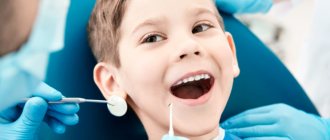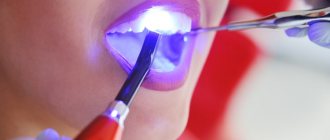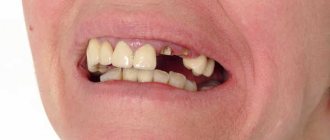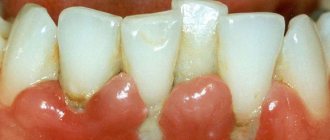Author of the article:
Soldatova Lyudmila Nikolaevna
Candidate of Medical Sciences, Professor of the Department of Clinical Dentistry of the St. Petersburg Medical and Social Institute, Chief Physician of the Alfa-Dent Dental Clinic, St. Petersburg
Caries is a disease that affects all people, regardless of their gender, age and place of residence. Caries is caused by bacteria that settle in the oral cavity due to poor nutrition and poor oral hygiene.
How are caries treated in dentistry?
If we are talking about caries, which has already overcome the stain stage and has begun to affect the soft and hard tissues of the teeth, then only a qualified dentist can help with its treatment. How to treat dental caries in a particular patient, separately about caries during pregnancy, the doctor determines individually after a visual examination of the tooth, an x-ray and other diagnostic methods.
Most often, when treating caries, the following algorithm of actions is followed:
- Cleaning teeth from plaque. The dentist removes plaque and deposits (both soft and hard) from the tooth. To do this, the doctor uses professional tools and special abrasive pastes. Massive dental plaque is removed using special ultrasonic attachments.
- Determining the color of the tooth being treated. Using a special scale, the dentist selects the shade of the tooth enamel so that the filling is not visually noticeable in the future.
- Anesthesia. If we are talking about the middle or deep stages of caries, the doctor uses anesthesia. The dentist determines the choice of a specific drug, as well as the place of its administration, on an individual basis.
- Removal of affected tissue. At this stage, the dentist drills out the edges of the enamel and removes the caries-affected area on the dentin. It is very important that all carious tissue is carefully removed and cleaned, otherwise, subsequently, under the filling, caries will continue its destructive effect and lead to various complications, such as periodontitis or pulpitis.
- Isolation of the tooth being treated from saliva. To do this, the dentist can use gauze or cotton swabs, which are used to cover the tooth on all sides. Also, to isolate from saliva, the doctor can use a modern rubber dam - a special latex with holes. It can be used to isolate several teeth at once.
- Treatment of carious cavity with antiseptics and medications.
- Etching is the treatment of dentin and tooth enamel with acid. After the gel penetrates deeply into the tooth tissue, its remnants are washed off and the tooth surface is dried.
- Insulating gasket. It is placed at the bottom of the cavity to avoid shrinkage of the filling.
- Direct tooth filling. On an individual basis, the dentist selects a filling material and places a filling, thereby restoring the original shape of the tooth.
- The final stage of caries treatment, which includes grinding and polishing the installed filling. The surface of the filling will become smooth, and the patient will not have any unusual sensations in the mouth.
Laser dental treatment
The latest laser systems have become firmly established in today's medicine; they are also successfully used in dentistry. Laser dental treatment is an opportunity to quickly, and most importantly - without the slightest discomfort and generally without pain, treat caries in the initial stages, treat gum diseases, and carry out whitening and hygiene procedures. The laser has become a real salvation for those people who are afraid to have their teeth treated, because it allows them to undergo treatment without experiencing any fear or pain, even without anesthesia.
A laser beam can be used instead of the notorious dental drill, the mere mention of which may be unpleasant for you - the laser successfully and very carefully removes areas of the tooth affected by caries, while simultaneously disinfecting dental tissues. It is also used instead of a scalpel during implantation, as well as some other dental operations. Unlike a scalpel, the laser beam acts bloodlessly, very accurately and painlessly, while ensuring complete sterility of the surgical field.
Dentist at the 32 Dent clinic Andrey Andreevich Koloskov says: “Our clinic uses the latest laser systems, the work of which many of our patients have already been able to evaluate. Yes, laser dental treatment is more expensive than usual, but for those people who are not too fond of being treated by dentists, it is optimal. Anesthesia is usually not required for this treatment because it does not cause any pain or discomfort.”
How to treat caries using traditional methods
Of course, it will not be possible to cure even average caries using traditional methods; you can only temporarily relieve the pain while you wait for an appointment with a doctor.
For this you can use:
- saline mouth rinse;
- camphor alcohol - by moistening a cotton swab with it, you can wipe not only the sore tooth, but also the gum near it;
- fir oil - a swab moistened with it should be placed on the tooth and adjacent gum and held for half an hour;
- alcohol infusion of horseradish - grate the horseradish, pour in vodka, leave for a couple of days, strain and apply a swab moistened with it to the sore tooth for ten minutes;
- infusion of onion peels - take a few spoons of onion peels, pour boiling water, leave for 24 hours, strain and rinse the mouth several times a day;
- garlic juice - get garlic juice using a blender or a garlic press, moisten a tampon in it and apply it to the tooth for 10-15 minutes.
You can also use traditional methods to treat caries in the initial stage - the spot stage. Here they will come to the rescue:
- sage decoction: you can rinse your mouth with the prepared solution almost an unlimited number of times;
- infusion of raspberry and mint leaves: leave the chopped leaves in wine vinegar for three days, strain and rinse your mouth with the resulting infusion;
- chicory root: fresh root can be chewed, and dried, pour water, leave and rinse your mouth;
- laundry soap: prepare a solution of soap and water and rinse your mouth with it;
- propolis: place a piece of propolis on a sore tooth, press with a cotton swab and leave for a while.
Icon: caries treatment without preparation
In the early stages of caries, Icon dental treatment is successfully used when drilling is not required at all. Dental surfaces are treated with a special chemical composition, which, permeating the tissues, disinfects and seals them. Essentially, a special filling is placed on the tooth, but you don’t have to drill into it for this filling. Unfortunately, treatment of caries without Icon preparation can only be used at the beginning of the development of the disease, when there is not yet a deep cavity in the diseased tooth. Therefore, for those who want to be treated quickly and painlessly, without an unpleasant preparation procedure, it is better to consult a doctor at the first signs of caries.
Veronika Aleksandrovna Ivantsova, dentist at the 32 Dent clinic: “The Icon dental treatment today is the most famous and popular technique that does not require drilling of dental tissue. But besides this, there are other technologies without preparation: ozone therapy, when diseased cells are removed by ozone cleaning, a non-contact abrasive technique, which is very similar in its mechanism of action to regular teeth brushing. In a modern, well-equipped clinic, the patient can always be offered a choice of several options for painless and completely comfortable treatment.”
Why can't you try to get rid of caries yourself?
Only a dentist knows how to treat caries. Under no circumstances should you try to get rid of it yourself. Unfortunately, there are often cases when patients come to the dental clinic who tried to scrape off caries themselves and thereby only worsened the condition of their oral cavity.
Among these “barbaric” methods:
- removing carious stains or tartar using a file or sandpaper, which will cause severe damage to the enamel and will only accelerate the development of caries;
- cleaning the carious area with a needle: even if it is possible to remove the darkened area in this way, this will not stop the process of tooth decay;
- whitening dark carious spots using bleach or other bleaches: this can not only damage the tooth, but also cause a burn to the mucous membrane;
- whitening with vinegar: you can not only worsen the condition of damaged enamel, but also burn your gums and the inside of your cheeks.
Stages of caries development
Caries is usually classified according to location and severity. From the point of view of determining treatment tactics, the stage of disease development is of greatest importance. In dentistry, there are 4 stages of development of dental caries:
- Elementary. The enamel layer gradually changes color - white spots appear on the surface of the teeth. Otherwise, caries occurs without a trace for the patient.
- Surface. Dark spots are visualized on the enamel. A damaged tooth does not react for a long time to cold, hot, sour and sweet foods.
- Average. The development of the disease leads to damage to dentin. Pain in response to external irritants is more pronounced and prolonged.
- Deep. The disease is accompanied by extensive damage to enamel and dentin. The pain does not go away even after using analgesics.
The earlier the stage of development of caries, the greater the likelihood that the disease can be cured with few sacrifices.
Why is it necessary to treat caries?
If you ignore the first symptoms of the disease and do not consult a dentist, then caries will continue its destructive effect and eventually reach the pulp of the tooth. After this, more serious treatment will be required, including removal of nerves and filling of canals. If you continue to ignore caries, you will not only have to endure toothache from time to time, but also prepare for the fact that in a couple of years you will lose your tooth forever. Keep in mind: a tooth that is filled in several places will last longer than a tooth that gradually decays. In addition, if the root remains alive, then it will be possible to put a crown on it, which is preferable to a denture.
You also need to monitor your health after the tooth is healed. If you feel discomfort in the area of the healed tooth under the filling, then it is quite possible that a gap has formed there where food can penetrate. As a result, caries may develop under the filling. After assessing the situation, the dentist may suggest removing the old filling, re-cleaning the cavity and installing a new one.
How will pulpitis be treated in the dentist's office?
Only a doctor can give you an exact answer to this question after examination and diagnostic measures. But in most cases, pulp removal is chosen. How will treatment be carried out using this method? Let us consider in detail all stages of the treatment process:
1. A patient comes to the dentist's office. The doctor carefully examines his oral cavity and the diseased tooth, and takes an image that allows him to assess the stage of development of inflammation. The patient is given an injection of an anesthetic drug.
2. The tooth is drilled with a drill to gain access to the pulp chamber, which contains the dental nerve. The doctor removes the pulp with a special instrument - a pulp extractor.
3. Another photograph of the tooth is taken, which will allow the doctor to see the shape, length and all branches of the dental canals.
4. The dentist carries out thorough cleaning and antiseptic treatment of the cavities of the dental canals. This is necessary to completely eliminate the risk of re-inflammation.
5. The canals are filled and the tooth is restored.
With this treatment regimen, it can be completed in one or two visits to the dentist. In some cases, patients are additionally prescribed antibacterial therapy.
This is how pulpitis is treated in a dental clinic. One of its most important stages is channel processing. If mistakes are made in this process, a relapse of the disease is possible.
In our dental clinic in Moscow - “Aesthetica”, treatment of canals for pulpitis is carried out under a microscope - an optical device that allows the doctor to accurately see all the structural features of the canals and qualitatively remove diseased tissue without affecting healthy tissue. This approach to the treatment of pulpitis guarantees high efficiency and allows you to save the tooth even in the most difficult cases!
Prevention of caries
What should you do to avoid caries?
- Regularly brush your teeth with high-quality toothpastes, for example, from the Asepta series. They ensure a sufficient supply of minerals to the enamel, break down plaque, and gently whiten.
- Limit the amount of sweets.
- Avoid eating sweets and starchy foods as a snack, before bed or immediately after brushing your teeth.
- Visit the dentist at least twice a year.
- Take care of your gum health.
- Follow the principles of proper nutrition.
- Choose the right oral and dental care products, and change your toothbrush regularly.
- Take vitamins and, if necessary, calcium, fluorine and phosphorus supplements.
- Eat solid foods regularly, such as apples and carrots, but at the same time avoid frequent consumption of seeds and nuts.
- Try to rinse your mouth after every meal, and if this is not possible, then at least chew sugar-free gum.
How is caries of permanent teeth treated in children?
Caries on permanent teeth is treated as in adults. The main method is filling. Photocomposites are the most successful for sealing the affected cavity. These are materials that do not differ in color or texture from teeth. Filling takes place in several stages:
- Introduction of anesthesia.
- Removing dead tissue using a drill and cleaning the cavity.
- Rinsing the tooth with an antiseptic.
- Air drying.
- Application of phosphate cement insulating gasket.
- Filling with composite materials in several layers, each of which must be dried with a special lamp.
For shallow caries, infiltration, remineralization or ozone therapy can be used. Silver plating is contraindicated.
Clinical researches
The effectiveness of ASEPTA series products has been repeatedly proven clinically. For example, multiple clinical studies have demonstrated that using ASEPTA propolis gum gel for a week can reduce gum inflammation by 31%. And the two-component mouth rinse ASEPTA ACTIVE more effectively combats the causes of inflammation and bleeding compared to single-component rinses - it reduces inflammation by 41% and reduces bleeding gums by 43%.
Sources:
- Comparative clinical evaluation of the effectiveness of treatment of traumatic lesions of the oral mucosa IORDANISHVILI A.K. *,** Doctor of Medical Sciences, Professor, Professor of the Department *Department of Orthopedic Dentistry of the Federal State Budgetary Educational Institution of Higher Education “North-Western State Medical University named after. I.I. Mechnikov" of the Ministry of Health of the Russian Federation (rector - Doctor of Medical Sciences Sayganov S.A.); **Department of Maxillofacial Surgery and Surgical Dentistry of the Federal State Budgetary Military Educational Institution of Higher Education “Military Medical Academy named after S.M. Kirov" of the Ministry of Defense of the Russian Federation (chief - Corresponding Member of the Russian Academy of Sciences, Professor A.Ya. Fisun).
- The role of anti-inflammatory rinse in the treatment of periodontal diseases (L.Yu. Orekhova, A.A. Leontyev, S.B. Ulitovsky) L.Yu. OREKHOVA, Doctor of Medical Sciences, Prof., Head of Department; A.A. LEONTIEV, dentist; S.B. ULITOVSKY, Doctor of Medical Sciences, Prof. Department of Therapeutic Dentistry of St. Petersburg State Medical University named after. acad. I. P. Pavlova
- Report on the determination/confirmation of the preventive properties of personal oral hygiene products “ASEPTA PLUS” Remineralization doctor-researcher A.A. Leontyev, head Department of Preventive Dentistry, Doctor of Medical Sciences, Professor S.B. Ulitovsky First St. Petersburg State Medical University named after. acad. I.P. Pavlova, Department of Preventive Dentistry
- Report on determining/confirming the preventive properties of toothpaste “ASEPTA PLUS” COFFEE and TOBACCO Author: doctor-researcher A.A. Leontyev, head Department of Preventive Dentistry, Doctor of Medical Sciences, Professor S.B. Ulitovsky. First St. Petersburg State Medical University named after. acad. I.P. Pavlova, Department of Preventive Dentistry
- Report on determining/confirming the preventive properties of toothpaste “ASEPTA PLUS” GENTLE WHITENING” Author: doctor-researcher A.A. Leontyev, head Department of Preventive Dentistry, Doctor of Medical Sciences, Professor S.B. Ulitovsky First St. Petersburg State Medical University named after. acad. I.P. Pavlova, Department of Preventive Dentistry
Preventive actions
Prevention of initial caries is aimed at proper oral hygiene. Try to brush your teeth after every meal. Use an antibacterial mouthwash and remember to brush the insides of your cheeks and tongue. Buy dental floss to easily remove food debris between your teeth. If finances allow, purchase an irrigator. This device thoroughly cleans teeth and removes pathogenic microorganisms from the enamel surface.
Let's consider a few more tips:
- Eat a balanced diet so that your body does not experience a deficiency of vitamins and microelements. Strengthen your immune system in every possible way. And, the most important rule, visit the dentist more often and promptly begin treatment for various oral ailments.
- It is important to maintain normal oral microflora. For this reason, you need to start treating colds in a timely manner and check your stomach condition once a year.
- An excellent preventative measure is to coat the enamel with fluoride varnish. This coating prevents bacteria from multiplying and prevents the development of superficial caries. For the highest efficiency, the procedure is carried out only 2 times a year.
- Dose out sweets, especially for children. Such products provoke the growth of bacteria. You should also limit liquids, which wash calcium from the body and make the enamel more vulnerable to the development of superficial caries.
Tooth root caries and its etiology on video
Risk group
The risk group for developing tooth root caries includes people who have periodontal disease. Deep periodontal pockets filled with dental plaque contribute to the penetration of the carious process into the pulp.
Elderly people are also at risk. They often experience gum recession, where the roots of the teeth are exposed. Against the background of age-related changes, the activity of the antiseptic properties of saliva decreases. This creates favorable conditions for the growth of bacteria and periodontal damage.
Common causes of root caries:
- Gum diseases. Any inflammatory processes that affect the soft tissues and ligaments of the tooth can lead to carious lesions of the pulp.
- Cervical caries. The lesion in this disease appears near the gum and can be invisible to patients for a long time, especially when located on the back surface of the teeth. Radical caries is more common against the background of exposure of the necks of the teeth. Timely treatment prevents infection from entering the nerve tissue.
- A decrease in the amount of saliva or a decrease in its antiseptic properties. In this condition, dry mouth occurs, creating conditions favorable for the proliferation of cariogenic microorganisms. Dry mouth can occur when taking certain medications, as well as due to age-related changes.
- Installation of a metal-ceramic crown. Dental prosthetics with crowns causes a slight receding of the gum level. This can lead to exposed necks of teeth and exposed roots.
Classic filling
requires a special approach when treating young patients, since the doctor has to use dental equipment, which often causes fear in children.
Aza&Buka dentistry uses both traditional and modern methods of treating caries of primary teeth, selecting a method taking into account the age of the child and the degree of neglect of the process.
Plaksina Margarita
“Modern parents are great! They themselves are not afraid of dentists, and children are taught the same thing: to come on time for preventive appointments and examinations. In such cases, doctors can intercept the very beginning of a cavity infection and prevent tooth decay without drilling.”
Loose front teeth
Loose front teeth are a wake-up call. Often this trouble happens with the front teeth. The main cause of looseness is gum disease: periodontal disease, stomatitis, gingivitis. You should not run them, otherwise you may end up without teeth at all.
The doctor will select the treatment for loose teeth individually. If the swaying is accompanied by pain, the teeth deviate significantly to the sides, the dentist applies special splints, removable or non-removable, to the incisors. Splinting strengthens mobile teeth, prevents their loss, and allows periodontal tissues to recover. In severe cases, surgical treatment cannot be avoided. During surgery, the surgeon removes bone tissue or restores it using metal shunts.
Cysts in the tooth canal and granuloma have a bad effect on the roots, and the teeth begin to become loose. These tumors need to be removed. If the tooth begins to loosen after a blow or injury, it is better to go for an x-ray.
Main signs of caries
Often, patients simply do not realize that they have tooth decay because they expect significant enamel damage, severe pain, or other common signs. But the best solution would be to contact our dentists in a timely manner for a thorough external examination.
There are several most common signs that a person is developing tooth decay:
- Change in enamel color. It can change color a lot. Stripes or dots of a dark or light shade appear. At this stage there may be no increased sensitivity or significant pain.
- Increased tooth sensitivity. It appears when eating hot and cold food, pressing, chewing, in the case of sweet or sour foods.
- Severe damage to the enamel. It is immediately noticeable by black holes in the teeth and partial destruction of the enamel.
- Pain. It can be of a different nature, either acute or long-lasting, aching. Depending on the type of problem, it either gets worse when pressing on the tooth or gets smaller.
- Bad breath. Occurs due to significant necrotic tissue damage.
Also, other manifestations are characteristic of the later stages of the disease - headaches, a feeling of shooting pain in the ears. For some, the inflammatory process stimulates fever, general weakness and decreased immunity.
Treatment methods – from filling to implant
The dentist will select the treatment method for the front teeth after an examination.
- Veneers or Lumineers
If the incisors are severely damaged, thin overlays can be placed - veneers or lumineers. They will hide the consequences of caries and make teeth whiter and smoother.
- Dental crowns
If only the root remains of the front tooth, intra-root inlays are made; this is the basis for the crown. Metal crowns are not suitable for front teeth; they will be too noticeable. To make an artificial tooth as similar as possible to a real one, it is better to use ceramic and zirconium crowns.
- Bridges and implants
If desired, missing front teeth can be replaced by bridges and clasp dentures. If funds allow, you can install an implant and forget about the problem for many years.
Air abrasive processing
The air-abrasive method involves mechanical treatment of carious lesions using special sandblasting machines, which are also used for professional oral hygiene. The idea of “knocking out” superficial caries with a stream of air containing impurities arose in the 40s in the USA. Then quartz sand was used as an abrasive (an impurity with high hardness), and later - aluminum oxide, a colorless and non-toxic substance. Flow-abrasive systems “shoot” with enough power to remove softened, caries-affected tissues without harming healthy ones. In the case of using air-abrasive treatment, the possibility of developing secondary caries is practically eliminated. The procedure is safe, painless, and does not require anesthesia when treating initial caries.
As with other methods of treating caries without a drill, the air-abrasive method does not heat the dental tissues and does not create noise or vibration. Moreover, it reduces the risk of microcracks forming, which can later cause destruction of the entire tooth. “Knocking out” with an air stream with abrasives occurs pulsed, for 5–10 seconds, which is more effective than dissection with a drill. The air-abrasive treatment method is not ideal, because in some cases it may still be necessary to clean out the caries with a drill and place only a composite filling. Sometimes this method of dental treatment is not applicable at all due to the inaccessibility of the installation tip to the affected area. Another disadvantage is the possible increase in tooth sensitivity in the future.


